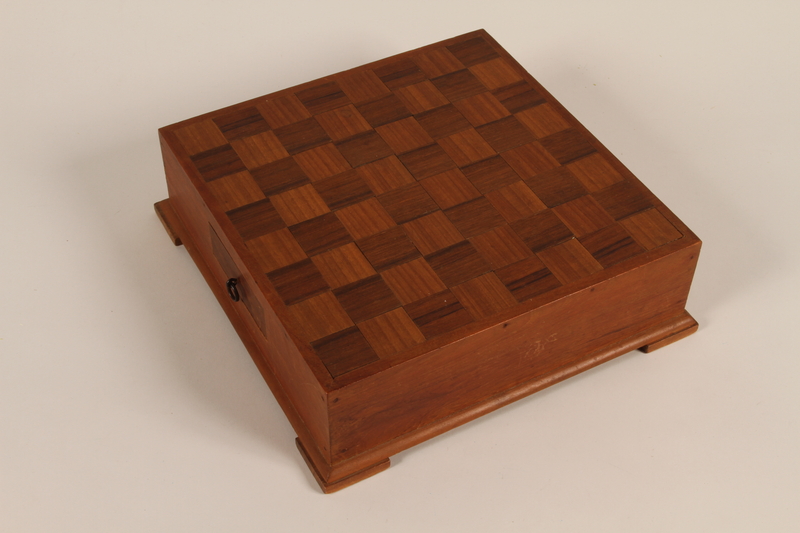Overview
- Brief Narrative
- Hand crafted parquet checkerboard with a pull-out drawer and 21 checkers given to Louis J. Walinsky, Director of ORT vocational training schools in displaced persons camps in Europe in 1947. It was made by ORT participants in a dp camp in the US occupation zone in Germany. After the war ended in May 1945, ORT opened vocational training schools in dp camps, the first in Landsberg in August. The schools trained Holocaust survivors in practical skills such as metalworking, carpentry, dress making, and mechanics, so they could establish new lives after they immigrated. Louis, a teacher and economist, began working for American ORT in 1947. He was sent to Europe to work for World ORT and became Director of ORT schools. Louis became Secretary-General for ORT in 1948, and returned to the US in 1949.
- Date
-
creation:
1947
received: 1947
- Geography
-
creation:
ORT School, DP camp;
Germany (Territory under Allied occupation, 1945-1955 : U.S. Zone)
received: ORT School, DP camp; Germany (Territory under Allied occupation, 1945-1955 : U.S. Zone)
- Credit Line
- United States Holocaust Memorial Museum Collection, Gift of Louis J. Walinsky
- Contributor
-
Subject:
Louis J. Walinsky
Subject: World ORT
- Biography
-
Louis Joseph Walinsky was born on April 19, 1908, in London, England, to a Jewish couple, Joseph (Ossip) and Rosa (Rose) Newman Walinsky. Louis had two sisters: Anna (1906-1997), and Emma (1921-2006). Louis’ mother Rosa (ca. 1885-1953) was born in Russia and was a poet and artist. His father Ossip (1886-1973) was born Joseph Melechinsky in Grodno, Lithuania. He was a labor leader and a Socialist. He was arrested for his political activity in 1904 but escaped to London. Ossip immigrated to New York in 1914. He moved to Toronto for work and was joined by Louis, Rosa, and Anna. The family settled in New York City in 1915. Louis attended Cornell University and received a degree in economics in 1929. He taught high school economics in New York. In 1932, he studied at the University of Berlin. In January 1933, Hitler came into power in Germany. Louis left Germany that March because of rising anti-Semitism. He resumed teaching in New York. In August 1933, Louis wrote the anti-Nazi play “Heil Hitler.” It was published in 1936 and banned in Nazi Germany by Heinrich Himmler in June 1937. Louis married Michele Benson (1912-2003). The couple had a son, Adam, born in 1937, but later divorced.
Following the December 7, 1941, attack on Pearl Harbor, the United States entered World War II. In 1943, Louis left his teaching job for a position at the War Production Board in Washington, DC. He worked for the program committee in the pulp and paper area and later became head of the Research and Analysis group. From 1944 to 1945, he was the executive secretary of the Combined Pulp and Paper Commission of the Combined Raw Materials Board. The war in Europe ended on May 7, 1945, with the surrender of Germany, and in Asia on September 2, 1945, with the surrender of Japan. Louis then worked for the Civilian Production Administration. In 1947, Louis began working for the American ORT Federation. ORT was an aid organization that since 1880 had assisted impoverished or persecuted Jews by instructing them in trades and agriculture, including farming, sewing, and mechanics. They were active in many Jewish ghettos during the Holocaust and during and after the war provided services to displaced persons and refugees. Louis was sent to Munich, Germany, to take over ORT operations in Germany and Austria in the American and British zones of occupation. He served as Director of ORT vocational training schools, which were established in displaced persons camps in Europe to rehabilitate and train Holocaust survivors. Students learned practical skills, such as metalworking, dress making, mechanics, and carpentry, which could help them establish themselves after they emigrated. Louis worked with the American Joint Distribution Committee (AJDC) to get supplementary rations for the students. They bought cigarettes and gave them to the students as inducements and to the instructors as part of their compensation. Louis standardized ORT courses and improved supplies. In 1948, Louis was designated Secretary-General for ORT.
Louis married Dorothy Monie (1913-1987). They had two daughters, Marian and Louisa. After leaving ORT in 1949, Louis worked as an economist. From 1953 to 1958, Louis served as Chief Economic Advisor for Burma. After 1963, he worked as a consultant for the World Bank. He wrote several books on economic development. From 1979 to 1980, he was the Executive Director of the International Commission of the World Jewish Congress. Louis, 93, died on December 24, 2001, in Washington, DC.
World ORT is the world’s largest Jewish education and vocational training non-governmental organization. Obschestvo Remeslenovo i. Zemledelcheskovo Trouda (Society for Trades and Agricultural Labor), called ORT, was founded in 1880 in St. Petersburg, Russia. ORT was created to assist impoverished Russian Jews by instructing them in trades and agriculture, including farming, sewing, and mechanics. During World War I (1914-1918), ORT provided assistance to thousands with soup kitchens, credit offices, cooperative workshops, and a relief-through-work program for displaced Jews. In the 1920’s and 1930’s, the organization expanded across Europe and into North American and South America, opening vocational and agricultural schools. In 1921, World ORT Union was established in Berlin. In 1922, the American ORT Society was founded.
World War II began when Germany invaded Poland on September 1, 1939. ORT was based in France, where it established vocational courses in internment camps for Jewish refugees who had been imprisoned as enemy aliens. Germany invaded France on May 10, 1940. During the war, ORT established vocational schools in several eastern European ghettos, teaching skills that were necessary for survival. ORT was most active in the Warsaw ghetto in Poland and the Kovno ghetto in Lithuania. In Warsaw, the German authorities only allowed technical courses, but teachers attempted to prepare their students for a future at universities. In Kovno, Jacob Oleiski, the head of ORT Lithuania, established a trade school for 40 children. Vocational schools were also established for Jewish refugees in Shanghai, New York, and Cuba. The war in Europe ended when Germany surrendered on May 7, 1945.
After the war, ORT became active in displaced persons (DP) camps. DP camps were established to house concentration camp survivors, forced laborers, and other displaced persons, with the goal of returning them to their home countries. However, most survivors did not want to return to their native countries and instead chose to immigrate to Palestine or the United States to begin new lives. In August 1945, the first ORT school was opened in Landsberg DP camp in Germany. ORT opened vocational schools in several DP camps, training over 80,000 Jews. They taught students practical skills that would help them after they immigrated. The courses were short, usually only a few months, because the students wanted to immigrate as soon as possible and did not want to commit to a longer course. Initially the classes were taught by displaced persons who had careers in relevant areas before the war. ORT eventually hired German instructors for some subjects, such as electricians and radio mechanics. Over 700 courses were established by late 1947. In May 1948, Israel was established. ORT formed workshops in Israel to help integrate Jewish refugees. The majority of DP camps in Europe were closed by 1952. The ORT office in Munich closed in 1957. World ORT Union's Technical Assistance department (renamed International Cooperation 1984) was set up to provide technical training programmes to disadvantaged communities outside the Jewish world in 1960. In 1979 ORT moved its administrative office to London, but the headquarters remain in Geneva. In 1991 ORT resumed operations in Russia. Programmes were also established in other countries of the CIS and Baltic States during the 1990s and early 2000s. In 2000 World ORT Union changed its name to World ORT. Today, ORT is active worldwide and provides skills training and self-help projects.
Physical Details
- Classification
-
Toys
- Category
-
Games
- Object Type
-
Gameboards (lcsh)
- Physical Description
- Hand crafted, square, stained, varnished wooden checkers board set into an open bottomed, boxlike platform with decorative, triangular foot supports at each corner. The playing board has 8 rows of 8 inlaid squares, 1.250 inches, alternating dark and light brown. There is a rectangular, shallow drawer with a metal ring pull inserted into 2 opposing sides of the platform: 1 drawer holds 10 light brown circular wooden checkers, the other holds 11 dark brown checkers, approximately 1 inch in diameter.
- Dimensions
- overall: Height: 3.125 inches (7.938 cm) | Width: 11.375 inches (28.893 cm) | Depth: 11.250 inches (28.575 cm)
- Materials
- overall : wood, varnish stain, metal, adhesive
- Inscription
- one checker, handwritten, black ink : G
Rights & Restrictions
- Conditions on Access
- No restrictions on access
- Conditions on Use
- No restrictions on use
Keywords & Subjects
- Topical Term
- Ex-concentration camp inmates--Education--Biography. Jewish refugees--Europe--History--20th century--Biography. Occupational retraining--Germany--20th century--Biography. Occupational training for Jews--Europe--Biography. Refugee camps--Europe--Biography. World War, 1939-1945--Civilian relief--Europe--Personal narratives.
- Geographic Name
- Germany (Territory under Allied occupation, 1945-1955 : U.S. Zone)--Personal narratives.
- Corporate Name
- World ORT Union
Administrative Notes
- Legal Status
- Permanent Collection
- Provenance
- The checkers game set was donated to the United States Holocaust Memorial Museum in 1988 by Louis J. Walinsky.
- Funding Note
- The cataloging of this artifact has been supported by a grant from the Conference on Jewish Material Claims Against Germany.
- Record last modified:
- 2024-02-26 11:56:38
- This page:
- https://collections.ushmm.org/search/catalog/irn514752
Download & Licensing
In-Person Research
- By Appointment
- Request 21 Days in Advance of Visit
- Plan a Research Visit
- Request to See This Object
Contact Us
Also in Louis J. Walinsky collection
The collection consists of a set of bookends,a glass bowl, brooch, case, cigarette lighter, gameboard, portfolio cover, shoulder badge, and stickpin relating to the experiences of Louis J. Walinsky while he was Director of the World ORT vocational schools in displaced persons camps in Germany in 1947.
Date: 1947

Hand cast ORT bookends presented to Director, ORT schools, DP camps
Object
Two cast metal ORT bookends presented in 1947 to Louis J. Walinsky, Director of ORT vocational training schools in displaced persons camps in Europe in 1947. It was made in a dp camp in the US occupation zone in Germany. After the war ended in May 1945, ORT opened vocational training schools in dp camps, the first in Landsberg in August. The schools trained Holocaust survivors in practical skills such as metalworking, carpentry, dress making, and mechanics, so they could establish new lives after they immigrated. Louis, a teacher and economist, began working for American ORT in 1947. He was sent to Europe to work for World ORT and became Director of ORT schools. Louis became Secretary-General for ORT in 1948, and returned to the US in 1949.
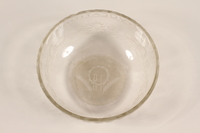
Glass bowl etched ORT presented to Director, ORT schools, DP camps
Object
Etched glass presentation bowl given to Louis J. Walinsky, Director of ORT vocational training schools in displaced persons camps in Europe in 1947. It was made in Landsberg am Lech dp camp in the US occupation zone in Germany. After the war ended in May 1945, ORT opened vocational training schools in dp camps, the first in Landsberg in August. The schools trained Holocaust survivors in practical skills such as metalworking, carpentry, dress making, and mechanics, so they could establish new lives after they immigrated. Louis, a teacher and economist, began working for American ORT in 1947. He was sent to Europe to work for World ORT and became Director of ORT schools. Louis became Secretary-General for ORT in 1948, and returned to the US in 1949.

Black leather case presented to the Director, ORT vocational schools, DP camps
Object
Black leather portfolio inscribed as a gift for Louis J. Walinsky, Director of ORT vocational training schools in displaced persons camps in Europe in 1947. It was made in Belsen displaced persons camp in the US occupation zone in Germany. After the war, ORT opened vocational training schools in dp camps, the first in Landsberg in August. The schools trained Holocaust survivors in practical skills such as metalworking, carpentry, dress making, and mechanics, so they could establish new lives after they immigrated. Louis, a teacher and economist, began working for American ORT Federation in 1947. He was sent to Europe to work for World ORT and became the Director of ORT schools. Louis became Secretary-General for ORT in 1948, and returned to the US in 1949.
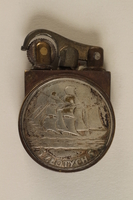
Cigarette lighter with Polish coins given to Director, ORT schools, DP camps
Object
Brass cigarette lighter with two inset prewar Polish coins presented to Louis J. Walinsky, Director of ORT vocational training schools in displaced persons camps in Europe in 1947. It was made by ORT participants in Ansbach dp camp in the US occupation zone in Germany. After the war ended in May 1945, ORT opened vocational training schools in dp camps, the first in Landsberg in August. The schools trained Holocaust survivors in practical skills such as metalworking, carpentry, dress making, and mechanics, so they could establish new lives after they immigrated. Louis, a teacher and economist, began working for American ORT in 1947. He was sent to Europe to work for World ORT and became Director of ORT schools. Louis became Secretary-General for ORT in 1948, and returned to the US in 1949.
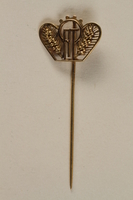
ORT stickpin presented to Director, ORT vocational schools, DP camps
Object
Gold stickpin with the ORT insignia given to Louis J. Walinsky, Director of ORT vocational training schools in displaced persons camps in Europe in 1947. It was made by ORT participants in a dp camp in the US occupation zone in Germany. After the war ended in May 1945, ORT opened vocational training schools in dp camps, the first in Landsberg in August. The schools trained Holocaust survivors in practical skills such as metalworking, carpentry, dress making, and mechanics, so they could establish new lives after they immigrated. Louis, a teacher and economist, began working for American ORT in 1947. He was sent to Europe to work for World ORT and became Director of ORT schools. Louis became Secretary-General for ORT in 1948, and returned to the US in 1949.

ORT shoulder badge owned by the Director, ORT vocational schools, DP camps
Object
ORT insignia shoulder patch owned by Louis J. Walinsky, Director of ORT vocational training schools in displaced persons camps in Europe in 1947. It was for uniformed personnel and worn at the ORT Headquarters in Munich, Germany. After the war ended in May 1945, ORT opened vocational training schools in dp camps, the first in Landsberg am Lech in August. The schools trained Holocaust survivors in practical skills such as metalworking, carpentry, dress making, and mechanics, so they could establish new lives after they immigrated. Louis, a teacher and economist, began working for American ORT in 1947. He was sent to Europe to work for World ORT and became Director of ORT schools. Louis became Secretary-General for ORT in 1948, and returned to the US in 1949.
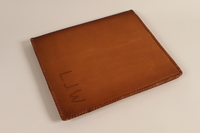
Monogrammed leather binder made for Director, ORT vocational schools, DP camps
Object
Brown leather secretary's notebook presented to Louis J. Walinsky, Director of ORT vocational training schools in Europe in 1947. It contains blotting paper and was made in an ORT Esslingen displaced persons camp class in Germany, and stamped with the camp name and his initials. After the war, ORT opened vocational training schools in displaced persons camps, the first in Landsberg am Lech in August 1945. The schools trained Holocaust survivors in practical skills such as metalworking, carpentry, dress making, and mechanics, so they could establish new lives after they immigrated. Louis, a teacher and economist, began working for American ORT Federation in 1947. He was sent to Europe to work for World ORT and became Director, ORT schools. Louis became Secretary-General for ORT in 1948, and returned to the US in 1949.
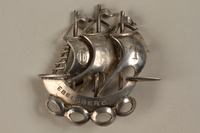
Silver brooch of a 3 masted ship given to Director, ORT schools, DP camps
Object
Brooch of a 3 masted ship engraved ORT Ebelsburg given to Louis J. Walinsky, the Director of ORT vocational training schools in Europe in 1947. It was made in Ebelsberg displaced persons camp in Austria. After the war, ORT opened vocational training schools in dp camps, the first in Landsberg in August. The schools trained Holocaust survivors in practical skills such as metalworking, carpentry, dress making, and mechanics, so they could establish new lives after they immigrated. Louis, a teacher and economist, began working for American ORT Federation in 1947. He was sent to Europe to work for World ORT and became the Director of ORT schools. Louis became Secretary-General for ORT in 1948, and returned to the US in 1949.
Louis J. Walinsky papers
Document
The papers consist of photographs of vocational classes at World ORT Union schools located in DP camps in Germany after World War II.
Book
Object
Short history of ORT activities in the displaced persons camps in the US occupation zone in Germany co-written by and owned by Louis Walinsky, ORT Director of vocational schools in displaced persons camps in Europe in 1947. The other author, Jacob Olejski, was a German Jew and survivor of Stutthof and Dachau concentration camps. Jacob became an official in dp camps in the American occupation zone of Germany and remained with World ORT Union, after 1955, in Israel. Olejski and Walinsky met working in dp camps. After the war ended in May 1945, ORT opened vocational training schools in dp camps. The schools trained Holocaust survivors in practical skills such as metalworking, carpentry, dress making, and mechanics, so they could establish new lives after they immigrated. Louis, a teacher and economist, was sent to Europe to work for World ORT. Louis became Secretary-General for ORT in 1948, and returned to the US in 1949.
Women's American ORT reporter (New York, New York) [Newspaper]
Object
Issue of the newspaper published by Women's American Ort in Mar 1972 kept by Louis Walinsky, ORT Director of vocational schools in displaced persons camps in Europe in 1947. It has an article by Jacob Olejski on ORT's work in dp camps in Germany. Olejski and Walinsky met working in dp camps. After the war ended in May 1945, ORT opened vocational training schools in dp camps. The schools trained Holocaust survivors in practical skills such as metalworking, carpentry, dress making, and mechanics, so they could establish new lives after they immigrated. Louis, a teacher and economist, was sent to Europe to work for World ORT. Louis became Secretary-General for ORT in 1948, and returned to the US in 1949.

